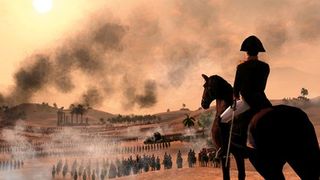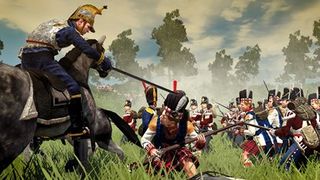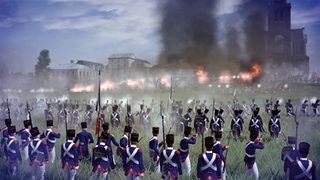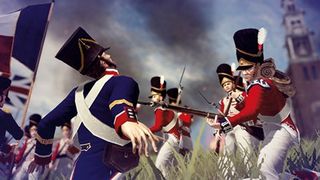Napoleon: Total War - hands on
Just how real is this historical war simulator?
Map 2: Battle of the Pyramids
One of Napoleon’s most famous victories was earned against a combined Ottoman and Mamluk force, which entered the field a few miles from the Pyramids. Again, both armies had advantages over the other: the French had superior troops and cannon, while the Mamluks were used to fighting in deserts. They also had units of fearsome cavalry, which they’d have to use effectively to win.

This time it would be a human opponent that faced off against us. His cocky swagger didn’t put us off our game and our men steeled themselves for his brash onslaught. As you can see on the map, our initial movements were minor at best, mainly straightening out the line and allowing ourselves to bring more men forward to fire when necessary. My thin lines would be easily broken if engaged by cavalry, but the plan was to make sure the enemy horses didn’t get anywhere near them.
Sitting in our defensive position, we watched as the Mamluks advanced, noticing that our small collection of units defending the nearby village was being approached by Mamluk cavalry. Two infantry units lined along an impassable slope, meaning the enemy had to funnel through a narrow gap if they wanted to engage. A volley of musket fire took out a surprising number and the charge faltered. The unit defending the gap swiftly reordered itself into a square formation and the reckless Mamluk charge was easily seen off. This was the key moment in the battle.

With his left flank broken, we seized the opportunity, sending a lone cavalry unit around behind the enemy lines. My opponent was too busy focusing on the joining of battle between our main lines to notice, and our cavalry came smashing into his limbered cannons, moving swiftly between each unit and destroying them with minimal casualties suffered.
Amazingly, we were able to take out every one of our opponent’s cannons before he noticed. Without their support, our front line, backed up sufficiently by their own cannons, stood firm. The battle looked to be going our way for a crushing victory, but the Ottoman’s and Mamluk’s advantage in terms of troop numbers proved important on our left flank. Sheer weight of numbers finally destroyed it and some swift reorganisation was necessary to prevent a disaster.

Anticipating the collapse, we had begun to wheel the rest of our line around, reorganising them into a smaller, more compact fighting force. No longer worried about cannon fire, we could reduce the length of the line and not worry about cannonballs thudding into our packed ranks.
Sign up to the GamesRadar+ Newsletter
Weekly digests, tales from the communities you love, and more
Fierce fighting on our left flank had weakened his advancing infantry, who were further disadvantaged by having a number of melee-only units in their ranks. My muskets whittled their numbers down, before a final flanking cavalry charge burst through their line from the side and sent them packing.

In the end, a dominant victory had been prevented by the vast numbers of the opposing force, but our opponent’s failure to protect his cannons meant his men were just too beleaguered by the time final battle was joined to see us off. It just shows: failing to pay attention to aspects of a battle is a fatal mistake.
Dec 24, 2009

After designing a Helldivers 2 Assault mission pitch "crazy similar" to one Arrowhead kicked around, fan returns with another concept that takes you right into the lair of the bugs

Director of upcoming Evil Dead spin-off teases the horror movie - "crazy, lots of Deadites, a big statement"

The Fallout TV show finally corrects my big game frustration: giving romance the focus it deserves
Most Popular



